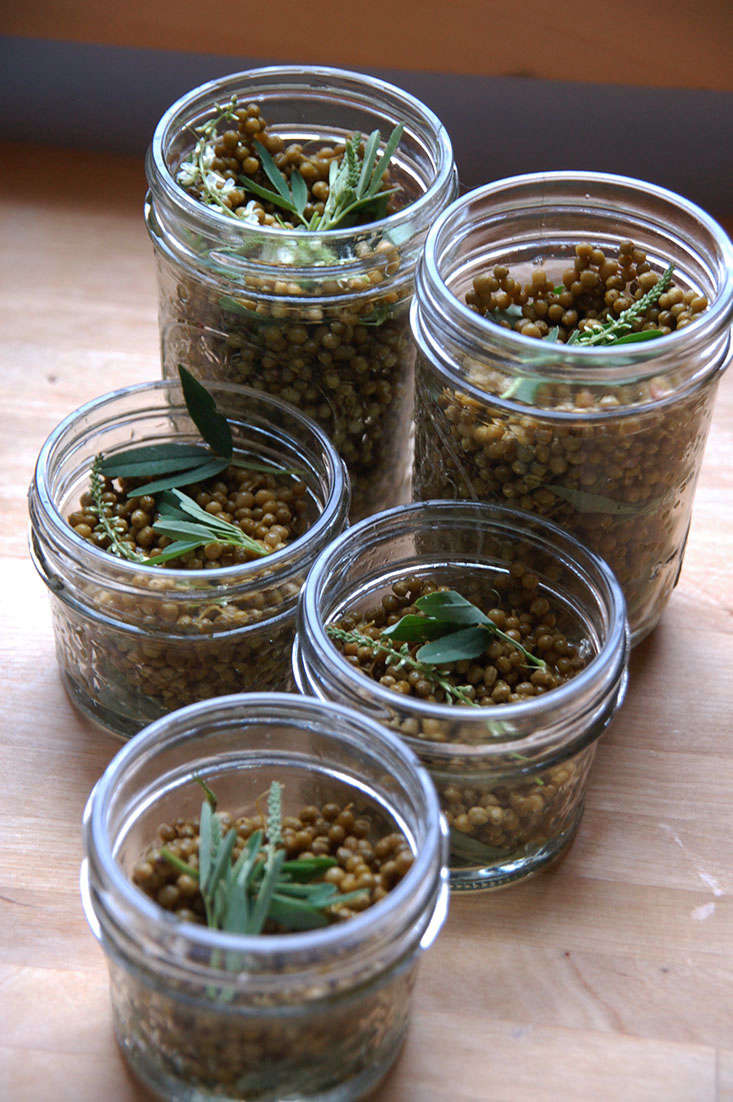In renowned forager Pascal Baudar’s new book, The New Wildcrafted Cuisine—Exploring the Exotic Gastronomy of Local Terroir, the LA-based author explores flavor and terroir, revealing how he uses both old and subversive culinary techniques to create his trademark wild-food dishes.
Hotly anticipated by the foraging world, the book does not disappoint. Illustrated by Baudar’s photographs, it is original in an age where very little is. From familiar elderflower cordial to the challenging lerp sugar collected from insects, by way of ubiquitous and invasive mugwort, this is armchair travel, a thrill ride, and kitchen survivalism combined, underscored by the author’s passion for place and ultimately, his appetite for really good food.
In partnership with Chelsea Green Publishing, we’ll be giving away a hardcover copy to a Gardenista reader. To enter the giveaway contest:
- You must reside in the contiguous 48 United States.
- Leave a comment below about a wild food you have eaten or would like to try.
- The contest ends at midnight PST on Friday, November 4. We will choose and contact by email a random winner, who must respond within 24 hours.
- The winner will be announced on November 12.
Photography by Pascal Baudar, except where noted, courtesy of Chelsea Green Publishing.
Above: In the introduction Baudar asks, “What are the real flavors of contemporary Southern California, the true cuisine?” He has provided the answer. Using wild mushrooms, seeds, herbs, leaves, stems, flowers, fruits, nuts, and bark, as well as the earth that surrounds them, Baudar has created a new language for food. His generosity has been to give readers the key to understanding it so that they can create their own, wherever they live.
Above: The book is organized by season. “If you think about it,” writes Baudar in the Fall section, “it’s quite amazing to be able to taste your own environment.” His detailed procedure for making a sourdough starter with local wild yeasts was inspired by his first success with wild elderberries as the source of yeast.
Above: Food preservation is a recurring theme in Baudar’s book (and also for anyone—gardener, forager, farmers’ market shopper—who has dealt with the poles of glut and deprivation). Elderberries feature again, unripe this time, in a recipe for elderberry capers.
Tantalizing glimpses of Baudar’s work have been posted online for years, in Facebook groups, and on Instagram. At classes he teaches with his equally gifted chef-girlfriend Mia Wasilevich (L.A. Magazine calls them “the first couple of foraging”), he leads foraging walks and then whips up beautifully plated snacks with the wild foods the group gathers. Baudar also supplies ingredients and finished products (like pickled black walnuts and aged vinegars) to high-profile chefs like Ludo Lefebvre. In New York, on an opposite coast, I have been inspired by his creative, erudite and disciplined approach to local flavors, which he acquires in the wilderness areas of southern California.
Above: What most readers would consider recipes are called “procedures” in the book’s pages. Baudar has explored and tested many ways of doing things, and emphasizes process over unwavering rules for quantities and ingredients. This allows for experimentation and creation by a reader who has mastered principles and method.
A recipe for pine needles, white fir, and lemon soda gives precise instructions as to the creation of a homemade soda (shown above), bubbles and all. Again, procedure is more important than a restricted list of plants. The introduction to cold-infused wild sodas spells that out. If you live in the Midwest? Use what grows in the Midwest. Technique will set you free.
Above: The author is a realist who knows that not everyone has the time or the desire to wild-source every ingredient. So he provides a method for making wild soda with store-bought juice, explaining that “you can still add some wild flavors to your drink by adding foraged ingredients,” such as yarrow or mugwort.
Above: Two pages are dedicated to the importance of observation when it comes to knowing when a batch of wild soda is ready. The much-dreaded explosion (it does sound like a bomb going off—I know) can be avoided and he tells you how.
Above: One of the easiest and most satisfying ways to experience and use foraged ingredients like sweet white clover is in flavoring homemade farmer’s cheese. Accompanying the accessible step-by-step instructions are appealing images.
Above: From the simple to the stratospherically esoteric, the most basic of meals—a baked potato—is elevated to the mouth-watering heights of the most delicious food entertainment. “You’ll probably need at least 7 to 10 pounds of [pine] rosin to start experimenting with this resin,”writes Baudar matter-of-factly. I’ll just watch. But it’s a lot of fun.
Above: Photograph by Mia Wasilevich.
Baudar is acutely aware of issues of sustainability when it comes to wild gathering, and tends some of his harvest grounds as a native farmer might have, harvesting just 20 percent from certain patches of chickweed, say, or broadcasting lamb’s quarters seeds just ahead of the rains, to make more for the next harvest. He is a pioneer of and an advocate for ethical wildcrafting and includes plenty of methods using invasive plants or plants in good supply. “As a forager,” he writes, ” you must assume the role of being a steward of the land. If you do so, the rewards will be plentiful.”
The rewards will be plentiful in your kitchen and pantry, too, after you have opened the pages of this groundbreaking book and learned its gentle and inspiring lessons.



















Have a Question or Comment About This Post?
Join the conversation